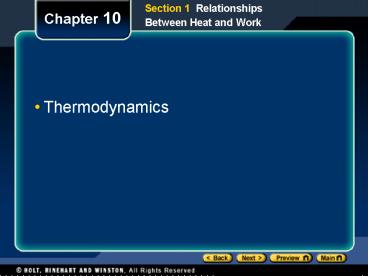Thermodynamics - PowerPoint PPT Presentation
1 / 15
Title:
Thermodynamics
Description:
Section 1 Relationships Between Heat and Work Chapter 10 Thermodynamics Section 1 Relationships Between Heat and Work Chapter 10 Objectives Recognize that a system ... – PowerPoint PPT presentation
Number of Views:319
Avg rating:3.0/5.0
Title: Thermodynamics
1
Section 1 Relationships Between Heat and Work
Chapter 10
- Thermodynamics
2
Objectives
Section 1 Relationships Between Heat and Work
Chapter 10
- Recognize that a system can absorb or release
energy as heat in order for work to be done on or
by the system and that work done on or by a
system can result in the transfer of energy as
heat. - Compute the amount of work done during a
thermodynamic process. - Distinguish between isovolumetric, isothermal,
and adiabatic thermodynamic processes.
3
Heat, Work, and Internal Energy
Section 1 Relationships Between Heat and Work
Chapter 10
- Heat and work are energy transferred to or from a
system. An object never has heat or work in
it it has only internal energy. - A system is a set of particles or interacting
components considered to be a distinct physical
entity for the purpose of study. - The environment the combination of conditions and
influences outside a system that affect the
behavior of the system.
4
Heat, Work, and Internal Energy, continued
Section 1 Relationships Between Heat and Work
Chapter 10
- In thermodynamic systems, work is defined in
terms of pressure and volume change.
- This definition assumes that P is constant.
5
Heat, Work, and Internal Energy, continued
Section 1 Relationships Between Heat and Work
Chapter 10
- If the gas expands, as shown in the figure, DV is
positive, and the work done by the gas on the
piston is positive. - If the gas is compressed, DV is negative, and the
work done by the gas on the piston is negative.
(In other words, the piston does work on the
gas.)
6
Heat, Work, and Internal Energy, continued
Section 1 Relationships Between Heat and Work
Chapter 10
- When the gas volume remains constant, there is no
displacement and no work is done on or by the
system. - Although the pressure can change during a
process, work is done only if the volume changes.
- A situation in which pressure increases and
volume remains constant is comparable to one in
which a force does not displace a mass even as
the force is increased. Work is not done in
either situation.
7
Thermodynamic Processes
Section 1 Relationships Between Heat and Work
Chapter 10
- An isovolumetric process is a thermodynamic
process that takes place at constant volume so
that no work is done on or by the system. - An isothermal process is a thermodynamic process
that takes place at constant temperature. - An adiabatic process is a thermodynamic process
during which no energy is transferred to or from
the system as heat.
8
Energy Conservation
Section 2 The First Law of Thermodynamics
Chapter 10
- If friction is taken into account, mechanical
energy is not conserved. - Consider the example of a roller coaster
- A steady decrease in the cars total mechanical
energy occurs because of work being done against
the friction between the cars axles and its
bearings and between the cars wheels and the
coaster track. - If the internal energy for the roller coaster
(the system) and the energy dissipated to the
surrounding air (the environment) are taken into
account, then the total energy will be constant.
9
Energy Conservation
Section 2 The First Law of Thermodynamics
Chapter 10
10
Energy Conservation, continued
Section 2 The First Law of Thermodynamics
Chapter 10
- The principle of energy conservation that takes
into account a systems internal energy as well
as work and heat is called the first law of
thermodynamics. - The first law of thermodynamics can be expressed
mathematically as follows - DU Q W
- Change in systems internal energy energy
transferred to or from system as heat energy
transferred to or from system as work
11
Signs of Q and W for a system
Section 2 The First Law of Thermodynamics
Chapter 10
12
Sample Problem
Section 2 The First Law of Thermodynamics
Chapter 10
- The First Law of Thermodynamics
- A total of 135 J of work is done on a gaseous
refrigerant as it undergoes compression. If the
internal energy of the gas increases by 114 J
during the process, what is the total amount of
energy transferred as heat? Has energy been added
to or removed from the refrigerant as heat?
13
Sample Problem, continued
Section 2 The First Law of Thermodynamics
Chapter 10
- 1. Define
- Given
- W 135 J
- DU 114 J
Diagram
Tip Work is done on the gas, so work (W) has a
negative value. The internal energy increases
during the process, so the change in internal
energy (DU) has a positive value.
Unknown Q ?
14
Sample Problem, continued
Section 2 The First Law of Thermodynamics
Chapter 10
- 2. Plan
- Choose an equation or situation
- Apply the first law of thermodynamics using the
values for DU and W in order to find the value
for Q. - DU Q W
Rearrange the equation to isolate the
unknown Q DU W
15
Sample Problem, continued
Section 2 The First Law of Thermodynamics
Chapter 10
- 3. Calculate
- Substitute the values into the equation and
solve - Q 114 J (135 J)
- Q 21 J
Tip The sign for the value of Q is negative.
This indicates that energy is transferred as heat
from the refrigerant.










![L 18 Thermodynamics [3] PowerPoint PPT Presentation](https://s3.amazonaws.com/images.powershow.com/6877662.th0.jpg?_=20150709116)




















